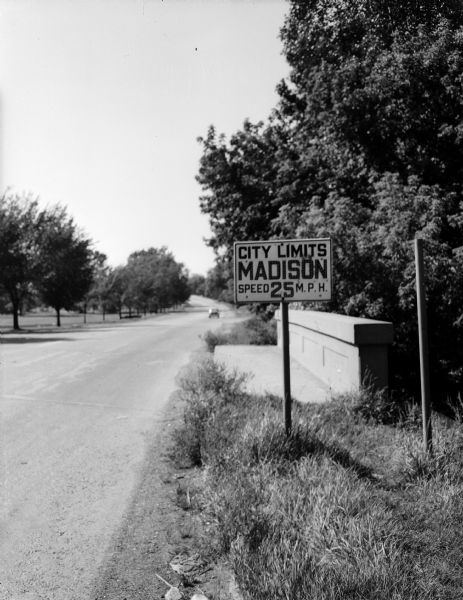The Automobile and the end of the City Limits
 |
| Leaving the Madison City Limits on Olin Ave. The automobile has lead to a blurring of urban and rural areas (Wisconsin Historical Society Image ID: 66970) |
The boundary between urban centers and the “wild” has been shifting over time. Historically, the city ended at the city limits, and beyond which was rural. Granted, “rural” does not always equate with “wild”, particularly in the Midwest where human development and disturbances have altered/destroyed much of the prairies and forests in the region. However, these rural areas, particularly forested areas, must be managed differently compared to cities in order to preserve their ecological functions. This includes hunting, regulated logging, and potential for fires. In urban areas, infrastructure is paramount to efficient living, and generally the issues of wildlife are avoided (e.g. bears, deer). Normally, these different land use functions between urban and rural areas would not be an issue since rural areas are inherently lacking much built structures.
What we’ve experienced in the past 60 years is the increased accessibility of these remote regions via the automobile. Combined with arguably poor planning, the divisions between urban and rural/wild have become increasingly blurred. The development of the “exurbs” or the “Wild Urban Interface (WUI)” has made this separation much more difficult to distinguish, and along with it, an increase in the difficulties of effective land management and infrastructure.
Now, the vast distances between buildings in the exurbs has led to a wildly inefficient method of infrastructure with many more miles of electric wires, pipes, and roads for each building served. This makes the convenience of living much more expensive to achieve. Furthermore, the normal land management strategies are difficult to accomplish; hunting is not possible near houses, apex predators are not compatible with human developments, and fires are much more likely to cause damage to buildings or lead to tragedy.
Besides the automobile making these rural regions accessible to population centers, one of the large causes with the WUI/Exurban development is that the true cost of building and residing is not entirely captured in the prices paid by the developer or owners. For example, electric bills are the exact same price per KW/hour for a new exurban house (which requires miles of wire to construct and maintain for the one house) as for a house in a city or dense suburb. Another example, particularly in western WUI regions is the subsidies placed on home fire insurances, which normally would provide a disincentivized to construct new buildings in the middle of fire prone regions.
Reflecting the true costs of exurban sprawl may prevent the habitat fragmentation and shrinkage of wild areas, but with one major downside – it prevents all people from enjoying the outdoors. We already live in a highly unequal economic society, and these policies would only extubatne the selectiveness of who can own their own slice of Northern Wisconsin. Perhaps what we need instead is the implementation of stricter land use policies in rural areas to ensure that exurban growth is reduces, while increasing the amount of low-intensity public land uses available. Camping opportunities, for example, are relatively low impact compared to a large lake house being constructed and are quite cheap to rent out. Expanding these types of experiences, along with land use planning and full cost inclusion might be necessary to balance rural preservation and recreational opportunities.
With the increase of exurban sprawl it becomes harder and harder to coherently answer and solve this problem of protecting our natural resources. Large impacts of this come from socio and economic factors like you mention making this a multifaceted problem. Yet I agree with what you say when providing education and experiences (like your camping example) that help keep this balance. Education of land managers and visitors and users will increasingly become important if we want to create this balance.
ReplyDeleteI agree, it seems that the only way to prevent exurban growth is through intensely strict land-use policies. However, I fear the issue with that approach is the shear amount of pushback it will receive from many people. It doesn't seem fair, but the politics of land use are deep, I wonder if there is any happy medium.
ReplyDelete